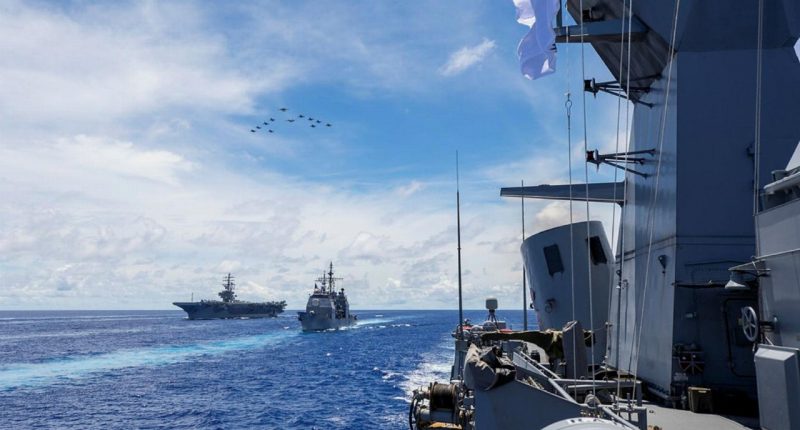- The Chinese navy has confronted Australian warships in the South China Sea en route to a military exercise with Japan and the U.S.
- Five ships, lead by HMA Canberra, were travelling through disputed waterways when they encountered the Chinese military
- The Joint Task Force was heading to the Philippine Sea at the time, where it planned to conduct military movements ahead of the biennial RIMPAC conference
- The exercise aimed to increase interoperability between the Australian, American, and Japnese navies, but came amid increasing tensions between the U.S. and China over territory in the South China Sea
- Speaking to the encounter, the Department of Defence said all “unplanned interactions with foreign warships throughout the deployment were conducted in a safe and professional manner”
The Chinese navy has confronted Australian warships in the South China Sea en route to a military exercise with Japan and the U.S.
HMA Ships Canberra, Hobart, Stuart, Arunta and Sirius were travelling near the Spratly Islands through disputed waterways when they encountered the Chinese military.
The Australian warships were on their way to the Philippine Sea at the time, where they planned to join allies and conduct military movements ahead of the biennial RIMPAC event.
ADF Joint task group Commodore, Michael Harris, said on Monday working with the U.S. and Japan was “invaluable.”
“Maintaining security and safety at sea requires navies to be able to cooperate seamlessly,” the Commodore explained.
The 🇦🇺 Task Group has joined the 🇺🇸 and 🇯🇵 in the Philippine Sea prior to transiting to Hawaii for Exercise RIMPAC. An important opportunity to exercise at sea with our close friends in support of our shared views of a prosperous, open & stable region. ➡️ https://t.co/jfieE4J8ga pic.twitter.com/fU6KkqNb4z
— Department of Defence (@DeptDefence) July 21, 2020
The tensions increase
The exercise aimed to increase interoperability between the Australian, American, and Japnese navies, but came amid increasing tensions with China.
Speaking to the encounter with the Chinese Navy, the Department of Defence said all “unplanned interactions with foreign warships throughout the deployment were conducted in a safe and professional manner.”
Recently, the eastern superpower was accused of using intimidation tactics and the COVID-19 pandemic to tighten its grip on territory in the South China Sea.
However, the U.S. has now stepped up its challenge on China’s territorial claims.
“We are making clear: Beijing’s claims to offshore resources across most of the South China Sea are completely unlawful, as is its campaign of bullying to control them,” U.S. Secretary of State Mike Pompeo said in early July.
The South China Sea
At present, China claims the majority stake in the South China Sea, an area which encompasses roughly 3.5 million square kilometres.
Significantly, in 2016, the United Nations Conference on Trade and Development (UNCTAD) estimated the South China Sea carried roughly one-third of all global shipping. In the same year, 64 per cent of China’s maritime trade passed through the waterway.
Meanwhile, Australia, Japan and the U.S.’ military exercise, dubbed the trilateral passage, is set to conclude today.
Next month, all three navies will head to the biannual Exercise Rim of the Pacific (RIMPAC) in Hawaii — the biggest global maritime warfare activity.
However, in 2018, China invitation to RIMPAC was withdrawn based on its ‘aggressive’ territorial claims in the South China Sea.
It’s understood China won’t participate in this year’s RIMPAC event either.








